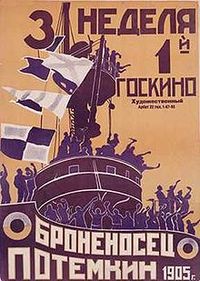The Battleship Potemkin: Difference between revisions
No edit summary |
No edit summary |
||
| Line 1: | Line 1: | ||
====Date: [[:Category: | ====Date: [[:Category:1926|1926]]==== | ||
====Region: [[:Category:Europe|Europe]], [[:Category:North America|North America]]==== | ====Region: [[:Category:Europe|Europe]], [[:Category:North America|North America]]==== | ||
| Line 48: | Line 48: | ||
{{DEFAULTSORT:Battle Potemkin, The}} | {{DEFAULTSORT:Battle Potemkin, The}} | ||
{{DISPLAYTITLE:<span style="font-style: italic;">The Battleship Potemkin</span>}} | |||
Revision as of 15:54, 5 August 2011
Date: 1926
Region: Europe, North America
Subject: Political/Economic/Social Opinion
Medium: Film Video
Artist: Sergeii Eisenstein
Confronting Bodies: French, British, American and Russian governments
Dates of Action: 1926, 1930s
Location: Eisenstein's films were censored worldwide, however the Soviet government frequently interfered with the production of his films
Description of Artwork: Most of Eisenstein's film were historically rooted and patronized by Soviet leadership. The films that launched Eisenstein into prominence were two historical films Strike (1924)and The Battleship Potemkin (1925) that dealt with worker's rights. Both received critical praise in the Soviet Union, but faced censorship abroad. The Battleship Potemkin was considered "powerfully seditious" by critics.
The Incident: The arrival of The Battleship Potemkin in Britain coincided with the General Strike of 1926 and was widely seen as being seditious. It was banned from public viewing by the home secretary. The Battleship Potemkin was banned in Britain until 1954.
Eisenstein's film The Battleship Potemkin (1926) was burned by French customs upon arrival, and banned by movie theaters in Pennsylvania because it "gives American sailors a blueprint as to how to conduct a mutiny."
In the 1930s after growing frustrated with these problems Eisenstein went to Europe and the United States to study the use of sound in the film industry there. While in Britain he tried to get the ban on The Battleship Potemkin lifted but could not. In the United States the director got a contract with Paramount Pictures. His decision to use Theodore Dreiser's book An American Tragedy as source material for his film raised objections with the studio and he left the United States without completing a film.
In 1937 at the Cinema Workers' Conference Eisenstein was forced to make a public apology for his "political and artistic errors".
Results of Incident: Eisenstein continued to make films, however, they were subject to the scrutiny of the Communist party. In 1948 Eisenstein died from a heart attack after the creative frustration and personal attacks became too much for him to bear.
Source: Censorship, A World Encyclopedia, ed. D. Jones
